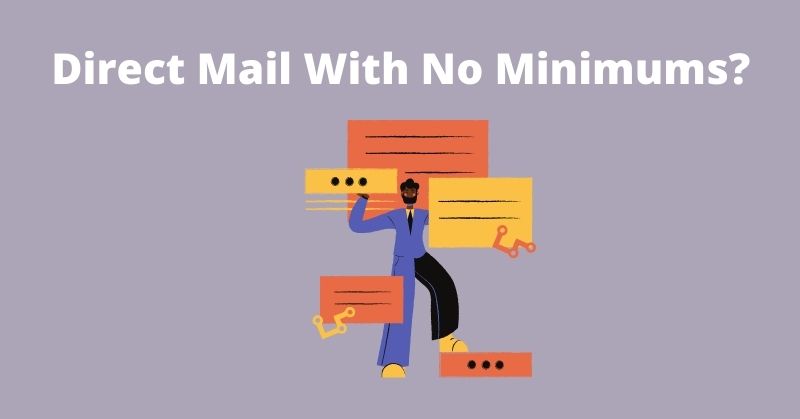
Most marketers have been led to believe that direct mail requires large volumes, minimum order sizes, and complex project management to be effective. But what if everything you know about direct mail minimums is outdated?
The advantages of direct mail marketing are well-documented, but the traditional barriers—high costs, complexity, and minimum spend requirements—have prevented many organizations from leveraging this powerful channel. After building email marketing campaigns that can easily send one message or 10,000, marketers often ask: “Why can’t we send direct mail with no minimum list size?”
The Problem: Traditional Direct Mail Minimums
Traditional printing companies base their workflows and profit margins on large runs of identical items. When overhead costs for prepress work and press setup are spread across small volume runs, the cost per piece skyrockets. Many printers even turn down low-volume jobs entirely.
This leaves innovative marketers in a bind. They want to leverage direct mail’s proven effectiveness, but need to send to small, targeted lists or through triggered workflows similar to their email marketing campaigns.
In traditional printing environments, only about 20% of project costs are related to actual printing. The majority of expenses come from:
- Postage
- File and document preparation
- Films, stripping, and platemaking
- Proofing
- Warehouse and inventory management
- Equipment cost and maintenance
- Waste
All these factors have historically made direct mail with no minimum sends virtually impossible.
For an in-depth discussion about technology fueled direct mail, see a series of articles here: https://www.postalytics.com/blog/direct-mail-advertising-in-the-digital-marketing-era/
Why Marketers Shouldn’t Give Up on Direct Mail
- Emotional Connection — When customers receive printed marketing materials, multiple senses trigger an emotional reaction. The tactile aspect of physical mail makes it more impactful and trusted than digital ads, according to research.
- Less Competition — Compared to the hundreds of digital marketing messages consumers receive daily, the physical mailbox contains relatively few items. USPS studies show most consumers check their mail every day, meaning direct mail pieces get noticed.
- Geographical Precision — Unlike email addresses, postal addresses define a single, unchanging physical location. For companies with local presence, this lets marketers target their best prospects with location-specific offers.
- No Filters or Blockers — Direct mail bypasses the digital gatekeepers. No internet service providers, spam filters, ad blockers, corporate firewalls, or junk folders stand between your message and your recipient.
- Complete Trackability — Techniques like personalized URLs (pURLs) and QR codes make it possible to identify individual responses. The USPS Informed Visibility program even lets marketers track mailpiece delivery in real-time, enabling perfectly timed multi-channel follow-ups.
For more benefits of direct mail, read: 47 Important Statistics on Direct Mail
Breaking the Rules: How Postalytics Eliminates Direct Mail Minimums
Marketers have been following rules that don’t apply anymore. Direct mail isn’t limited to high-volume campaigns—at least not with Postalytics.
Postalytics has rewritten the direct mail playbook by creating a technology platform that distributes print requests from multiple customer accounts to a network of vetted printing companies across the country. This shared resource approach, similar to how ride-sharing services like Uber operate, spreads fixed expenses across multiple users while covering the variable costs associated with individual mailings.
This revolutionary model allows:
- Direct mail with no minimum list size — Even single-piece triggered mailings become economically viable
- Lightning-fast turnaround — What used to take 4-6 weeks now takes 30 minutes
- Complete automation — No manual coordination, spreadsheets, or back-and-forth approvals
- Full integration — Direct mail becomes part of your marketing tech stack, not separate from it
By connecting Postalytics to their CRM systems (including HubSpot, Salesforce, High Level, ActiveCampaign, Zoho, Klaviyo, Marketo, and Zapier), marketers can send personalized direct mail at exactly the right moment. Mail can be triggered by website interactions, renewal dates, anniversaries, or any other data-driven criteria—with no minimum order sizes.
Here’s a quick video explaining how the Postalytics system works:
Here’s a case study that highlights a Postalytics customer that re-built their marketing workflows to take advantage of no minimum direct mail.
Targeted Direct Mail for Lists of Any Size
The data-driven targeting available through direct mail may surprise digital marketers. A wealth of demographic and behavioral data can be connected to postal addresses, allowing marketers to build variability into their direct mail designs.
Some commonly applied selection criteria include:
- Home ownership status
- Income and estimated net worth
- Household composition and number of children
- Age and gender
- Education level
- Credit rating
- For B2B: Number of employees, annual sales, and SIC codes
Using modern document composition methods and digital printing technology, campaigns of any size can include postcards or letters with elements uniquely tailored to each recipient. This level of variability was impossible with traditional printing methods, but recent developments in inkjet and toner-based presses now enable marketers to send highly variable, full-color mailpieces without minimum orders.hly variable full-color mailpieces that attract attention and encourage prospective customers to act.
Personalization: The Key to High ROI Direct Mail
Personalization is no longer about awkwardly inserting a customer’s name into generic text. Today’s sophisticated personalization creates relevance that feels like a fortunate coincidence rather than an obvious marketing tactic.
Consumers now expect more than being addressed by name—they want relevant offers in contexts that make sense for them. Through variable data manipulation and segmentation, marketers can easily adjust their presentations to match each customer’s profile.
Examples of Personalization Strategies for Direct Mail:
Purchase History — Offer existing customers discounts on related accessories or upgrades, while non-customers receive entry-level product offers and testimonials.
Gender — Adjust imagery to show relatable scenarios based on the recipient’s gender.
Location — Urban dwellers might receive images of city-based use cases, while suburban residents see content more relevant to their lifestyles.
Age — Marketing pieces can highlight different benefits based on age demographics, such as childcare services for younger recipients versus low-impact options for older audiences.
Job Role (B2B) — Messages to CEOs can focus on cost savings and competitive advantages, while CTOs receive content about technical integration and implementation.
In all these examples, data controls the images, text, and offers without explicitly mentioning the data points themselves. Here’s a tutorial about using variable images to personalize direct mail: Personalization — Variable Images
The Technology Revolution Behind Direct Mail with No Minimum

Before high-quality digital printing became available, each segment or variation would have required a separate press run, making personalization prohibitively expensive. By leveraging variable data capability and digital presses, even highly personalized campaigns from multiple customers become a single efficient print run.
The evolution of digital printing over the past decade has eliminated previous challenges around print quality and color costs. Modern digital presses produce full-color items on various substrates with quality indistinguishable from traditional offset printing.
This transition offers another crucial benefit—speed. The entire process that once included plate making, proofing, color-matching, and press setup is now dramatically faster. Most of those steps no longer exist, and many remaining steps are automated.
Though a basic understanding of how print is produced may be useful, unfamiliarity with printing terms and practices are no longer a barrier to taking advantage of the benefits direct mail provides.
For an introduction to printing terms, see The New Direct Mail Glossary.
Postalytics shields customers from the complexities of print production by:
- Vetting printing companies and monitoring their performance
- Providing an intuitive interface similar to email marketing platforms
- Generating print-ready files through its built-in document composition engine
- Eliminating the need for expertise in design software or printing terminology
The Future of Direct Mail Has No Minimums
Direct mail isn’t what it used to be—it’s better. Instead of being limited by outdated constraints, marketers can now run highly targeted, triggered, and personalized direct mail campaigns with no minimum send sizes, right from their desktops.
Postalytics has removed the traditional barriers by:
- Automating everything — Create, personalize, and launch campaigns in 30 minutes
- Eliminating minimums — Send one piece or thousands, it’s entirely up to you
- Enabling tracking — Every mailpiece is tracked like a digital campaign
- Seamlessly integrating — Direct mail becomes part of your marketing tech stack
The result? Direct mail that’s as fast, measurable, and flexible as email marketing—without the traditional project management nightmare.
Ready to challenge what you thought was possible with direct mail? Start sending direct mail with no minimum today.
About the Author

Dennis Kelly
Dennis Kelly is CEO and co-founder of Postalytics, the leading direct mail automation platform for marketers to build, deploy and manage direct mail marketing campaigns. Postalytics is Dennis’ 6th startup. He has been involved in starting and growing early-stage technology ventures for over 30 years and has held senior management roles at a diverse set of large technology firms including Computer Associates, Palm Inc. and Achieve Healthcare Information Systems.
